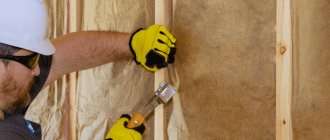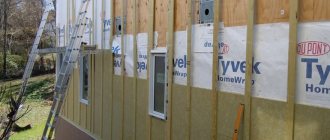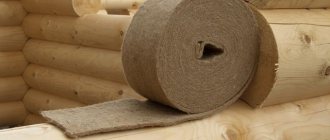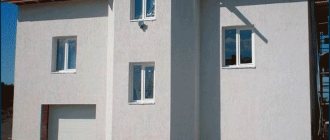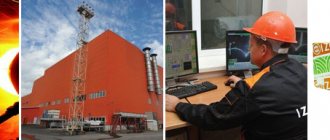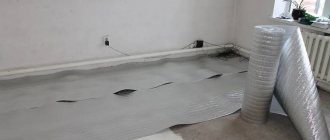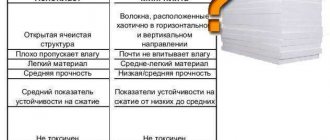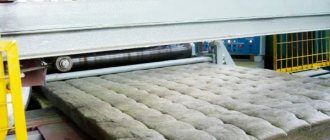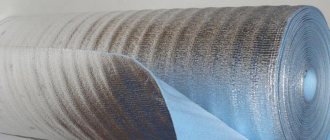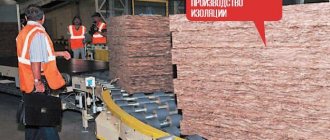Basalt insulation Isoroc Super Warm 100 mm 3.05 sq.m. Photo by Leroy Merlin
There is fierce competition in the modern building materials market. The direction of production and sale of insulation materials is no exception. Enterprises develop and produce high-quality materials in a wide range. The leading position is occupied by basalt (stone) wool. An extensive list of positive characteristics ensures the active use of basalt insulation to solve problems of varying complexity and scale. Recommendations for the use of basalt wool when insulating various structural elements and other information on application are presented below.
Description, properties and characteristics
Basalt wool is a type of mineral insulation , produced from fractions of mountain gabbro-basalt rocks through their processing (crushing, melting, stretching into fibers that are mixed with binding components) at high temperatures.
Natural rock of volcanic origin used as a raw material ensures that the materials have several important characteristics, in particular, a high melting point, resistance to open fire, environmental friendliness, long service life, and low water absorption coefficient.
Basalt insulation Paroc eXtra Smart 50x600x1200 mm 7.2 sq.m. Photo Petrovich
Basalt insulation also has properties such as low thermal conductivity, light weight, ease of transportation and ease of installation, excellent vapor permeability, and others. It is the whole list of positive characteristics and properties, as well as the variety of types, that ensures the demand for basalt-based materials.
Areas of application
In addition to thermal insulation, basalt wool also serves as a good barrier to noise. It is used both on walls and on ceilings. The main areas of application are:
- insulation of residential, industrial and domestic premises with basalt wool;
- basalt insulation is used for a suspended ventilated facade (the so-called “wet facade”);
- thermal insulation of ship structures;
- thermal insulation of sandwich panels and multilayer masonry;
- thermal insulation of high-temperature objects and pipes.
The operating temperature range from -120°C to 1100°C makes the material indispensable for thermal insulation of pipelines, boilers and industrial installations.
Advantages
The main advantages of the material include:
- Excellent thermal insulation. The fibrous medium contains air, which does not allow heat transfer.
Thermal insulation properties of basalt wool
- Soundproofing. It is explained by the fibrous structure that absorbs sound vibrations.
Fiber structure provides sound insulation
- Long service life (25-45 years).
- Resistance to aggressive environments (acid, alkaline, organic solvents and oils)
- Water resistance. Provided with special additives that displace moisture.
- Resistance to the development of mold and fungal cultures.
- Strength. The material can withstand high loads while maintaining its shape.
- Low specific gravity.
Basalt wool is made from natural materials; no harmful substances are used in the manufacturing process. The material is highly environmentally friendly and does not have a harmful effect on the human body during operation. During installation, it is necessary to use personal protective equipment (respirator) to prevent cotton wool fibers from entering the respiratory system.
Kinds
Manufacturers offer various types of thermal insulation materials. According to the form of release, there are slabs, rolls, cylinders, shells, and it is also possible to find cotton wool on sale in the form of granules. Recently, basalt cardboard , which is produced like mineral wool from basalt fiber, has attracted increased interest, only bentonite clay is used as binding components. Products produced in the form of sheets are actively used for insulating furnaces.
Basalt insulation ISOBOX ExtraLight-31 100Х600Х1200 mm/4.32m2/0.432m3/6pcs. Stroylandia Photos
Plates are divided according to their hardness , the higher the indicator, the greater the mechanical loads the product can withstand: soft, semi-rigid and hard. The density of materials varies widely – from 15 to 300 kg/cub.m. The size of products is another of the main criteria for classification. The length of the slabs is 1000-1200 mm, width - 600, thickness - 20-240.
Rolled cotton wool has the following average dimensions: length - 3000-10000 mm, width - 600-1200, thickness - 50-100. Foil insulation has some advantages over standard insulation. Each type of insulation is recommended for solving certain problems; the most popular ones are presented below.
Technology of wall insulation with basalt wool
As I already said, to achieve the best effect, it is necessary to insulate the internal and external walls.
Let's take a closer look at the process of insulating walls with basalt wool in stages. In both cases I do almost the same thing, but the sequence of work is slightly different.
The process of insulating external walls:
1. I cover the frame with OSB boards. There should be small gaps, approximately 2-3 mm. After installation they must be foamed;
2. I stretch a waterproofing membrane designed to protect the basalt wool and frame from moisture that can come from outside;
3. I install sheets of thermal insulation material. The density of basalt wool for wall insulation should be quite large, up to 50 kg/m3. Otherwise, the insulation will begin to roll down, which will lead to voids;
4. The thickness depends on climatic conditions, but on average it is 15-20 cm. In areas with a milder climate, a thickness of 10 cm is allowed;
5. After all the basalt slabs have been laid, I fill the voids with polyurethane foam;
6. From the inside I stretch a vapor barrier membrane designed to protect the insulation from moisture coming from inside the room. I stuff OSB sheets on top, but depending on the finish, it is possible to use other materials, for example, boards, slats;
7. It is important to make sure that you do not over-tighten the membrane at the inner corners - it should follow the angle of the frame. Otherwise, it will be difficult to nail the sheathing at these corners.
Insulation of internal walls
1. Basically, internal insulation is carried out for sound insulation. Therefore, instead of basalt wool, it is possible to use another soundproofing material;
2. There are no special requirements for insulating internal walls. Therefore, you don’t have to use waterproofing and vapor barrier materials;
3. Otherwise, insulation of internal walls is carried out in the same sequence as external ones.
After completing these steps, I cover the wall with decorative panels. Next, finishing work is carried out. Covering the inner surface can be done in various ways. You can use reinforced plaster, then putty and finally wallpaper or paint the wall.
Application: what is it used for, as insulation and other options
For chimney
The purpose of the chimney is to provide heat to the room. But do not forget that chimneys also need insulation. Basalt materials, which are suitable for insulating stainless, ceramic, asbestos, and brick pipes, are widely used to solve this problem.
Exiting the chimney pipe through the wall. Photo by NZSK
Insulation is important for several reasons:
- fire prevention;
- increase in service life; sudden temperature changes, exposure to alkalis and acids can lead not only to the destruction of the pipe, but also the surfaces and elements surrounding it: ceilings, walls, floors;
- heating the surface of the pipes negatively affects surrounding objects in the room, it also affects humans, thermal insulation prevents an unfavorable effect and ensures normal heat exchange;
- reducing the release of condensate, which can form harmful chemical compounds after reacting with other substances in the pipe.
The choice of type of heat insulator depends on the design of the chimney, its features and the wishes of the owners regarding thermal characteristics.
Cylinders and shells are used in home and industrial heating systems, used for external and internal insulation, at temperatures not exceeding 300 degrees. The cylinders have a longitudinal seam for ease of installation; the products are fastened with bandages made of galvanized or stainless sheet steel or binding wire made of black (diameter 1.2 mm) or stainless steel (2 mm). The joints are insulated with aluminum tape.
Plates and rolls are intended for structures whose contact temperature will be 450-700 degrees; they are recommended for use for pipes with non-standard diameters; they are not very suitable for structures passing through walls. For passage units, it is recommended to choose high-density insulation (more than 100 kg/cub.m.); foil plates are suitable for internal and external insulation of single-wall pipes.
Basalt cardboard is excellent for insulating brick chimneys and can withstand temperatures up to 900 degrees. Foil cardboard is recommended for external insulation.
The chimney pipe passes through wooden surfaces. Photo StroyDom
There are several recommendations that, if followed, will allow you to perform high-quality thermal insulation with your own hands:
- a protective screen is a mandatory design element if materials without foil were used for insulation;
- when laying mats in several layers, the joints must be covered with the following layers;
- passages through wooden surfaces should be insulated with cotton wool no less than 50 mm thick, the distance from the load-bearing beams should be at least one meter;
- when laying insulation in several layers, each subsequent layer should be laid with an offset of 180 degrees around the circumference and by 150-200 mm. by lenght;
- The thickness of the internal insulating layer is no more than 40 mm, the external one - up to 100.
In addition, you should adhere to some rules when working with systems made of different materials:
- Asbestos. Chimneys made of this material require external insulation. Sheets or rolls 30-50 mm thick. secured with special staples.
- Ceramics. The pipes are insulated with materials 30-50 mm thick, fastening is carried out using clamps.
- Steel. To organize the insulation, two pipes with different diameters are used: a larger one for the outer surface, a smaller one for the inner surface. One pipe is placed inside another. The resulting gap is filled with material. The end of the structure is additionally insulated. An alternative to the first three stages is to purchase ready-made sandwich pipes, which are characterized by low weight, high heat resistance and excellent heat-resistant characteristics.
- Brick. For insulation, mats or rolls are used, which are cut into layers with the required dimensions, they are fastened with tape, a protective screen is mounted on top, and, if necessary, the surface is plastered or painted. basalt insulation is also used for insulation in penetrations, the gaps between pipes and structures are filled with stone wool, for the manufacture of fire-resistant grooves, which serve to protect wooden surfaces located nearby.
For furnaces
The stove is a dangerous object, so proper installation and protection of surrounding objects from its heat is important. To solve this problem, various materials are used, including those based on basalt. Some recommendations for organizing a protective screen are presented in the corresponding article.
Insulation, how to insulate
The versatility of basalt wool allows it to be used for insulation of various structural elements of buildings. But each specific case has its own recommendations and features of the work. Isolation of individual premises is of particular interest to Internet users; the specifics of their isolation will be discussed further.
Cold attic ceilings
An uninsulated attic space is the most vulnerable part of a structure . About 20-40% of the thermal energy needed by residents “exits” from the house through the attic floors, the figure varies depending on the materials used in the construction of the rafter frame and roofing. Insulating the ceiling in houses with cold roofs will significantly reduce heat loss and, accordingly, save on home heating costs.
Before you begin choosing insulating materials and performing insulation work, you should decide on the purpose of the attic space. Insulation is carried out if the attic will serve as a non-residential space, for example, as a storage room. If you plan to make the attic heated, then it is necessary to insulate the roof.
Basalt insulation IZBA Standard is suitable for attic insulation. Photo source here
The roofing pie from the inside out will include the following layers: vapor barrier (a vapor-proof film is used), insulation (the vapor permeability of which should be higher than that of the vapor barrier) and waterproofing (since basalt wool does not absorb moisture, a regular waterproof film is suitable here). But this is another task, so let’s return to the insulation of attic floors, which is performed in two ways:
- 1) insulation from the attic side;
- 2) installation of insulation on the ceiling, i.e. from the side of the room.
1) The first method is the most common, since the process does not require special efforts from the performer . In addition, it is possible to save on materials; there is no need to cover the insulation with vapor and waterproofing. The materials dry out on their own when the attic is ventilated.
The insulation technology depends on the type of floor:
Reinforced concrete. The work includes several stages. Firstly, the surface is repaired and leveled. Secondly, a vapor barrier is performed, the canvas is placed with approaches to the walls. Thirdly, the insulation (it is more convenient to use rolls) is laid in two layers, the seams of the lower layer are covered with mats located in the second row - the arrangement is staggered.
Wooden. The process is carried out in several stages. Insulating materials are placed in the space between the joists, or more precisely in the cells between the joists. Before laying the insulation, a vapor barrier material is placed in each cell, extending onto the joists and walls. The insulation is cut, each layer should be 2 cm larger in length and width than the dimensions of the cell. The height of the insulation should be equal to the height of the logs. To insulate the attic space, it is recommended to choose materials with a density of no more than 30 kg/cubic meter.
2) Insulation technology from the room side, i.e. Ceiling insulation is more difficult to implement, but sometimes it is the only one possible, so we will consider it. Cotton materials are extremely rarely used to solve this problem. The installation process is very labor-intensive; it requires the construction of a frame, the presence of which will significantly reduce the height of the ceiling. As a result, there are two development options: either carefully consider ways of additional fixation of materials and their fasteners, or pay attention to other types of insulation.
Ceiling in the bathhouse
Basalt wool is ideal for insulating bathhouse elements. There are baths with and without an attic. In the first case, the quality of the ceiling insulation is not so important, since it is possible to focus on the insulation of the attic and roof. In the second, you need to approach the work as responsibly as possible .
Ceiling insulation is carried out during the construction stage. The choice of insulation also depends on the type of ceiling (floor, hemmed, panel). Basalt wool is suitable for any type of insulation. But flooring is the most popular, as it is budget-friendly. It should be remembered that the vapor barrier is installed closer to the room, and the waterproofing is installed on the attic/roof side. Each type of ceiling is an individual sequence of layers, details here.
False ceiling in the process of installation. Photo StroyDom
A comparison of basalt wool with other thermal insulation materials for ceilings, as well as recommendations for choosing the thickness of the material, are presented in a separate publication.
Many manufacturers offer special insulation for baths, so there will be no shortage of options to choose from. Some options for basalt insulation are presented here.
For facade
Insulation of facades is carried out for several reasons:
- heat conservation, therefore saving energy and money;
- removal of the place where condensate falls and settles from inside the wall material beyond its limits;
- the ability to design facades.
Rockwool insulation Rockfacade 100x600x1000 mm 1.2 sq.m. Photo Petrovich
Insulation of facades with basalt wool is carried out in three ways:
- increase the thickness of the walls;
- construct a ventilated façade by constructing a “pie” of insulation, a ventilation gap and waterproof sheet material;
- to carry out the organization of a non-ventilated facade by installing insulation and plastering the surface, this technology has an alternative name - the “wet” method, which we will consider in more detail in the next paragraph.
The cost of additional materials is higher than the price of insulation, so the first method is not suitable for solving problems. Thus, now we should pay attention to the technology of organizing a ventilated facade.
Preparation includes performing a number of tasks:
- removal of various objects and communication systems;
- cleaning the surface from old plaster and dirt;
- sealing defects: cracks, grooves, seams using foam;
- padding;
- treatment with a special compound to increase adhesion.
Installation of fiber insulation requires the formation of a frame , the distance between the guides of which should be 10-20 mm. smaller, the width and length of the slabs (! in this case, it is preferable to use insulation slabs). The height of the guides should be slightly greater than the thickness of the material to form a ventilation gap.
The stone wool is fastened using dowels with wide plastic rings at the ends (fungal dowels). A windproof membrane is placed on the heat-insulating materials , the sheets of which are overlapped - up to 100 mm, the joints are taped. Then a counter-lattice is formed , to which the finishing trim is attached; siding has been particularly popular lately.
Under plaster
The installation of a non-ventilated façade should be carried out at temperatures from +5 to +30 degrees, without wind or precipitation, in the shade from direct rays of the sun. The process includes the following steps:
- preparing the facade for work, removing old plaster coating, removing stains and soot, covering grooves and seams with adhesive foam, repairing cracks and other defects, removing dust;
- applying a primer, drying the surface;
- installation of the base profile;
- “laying” the insulation (the optimal layer thickness is at least 100 mm) begins with applying an adhesive composition to the materials and gluing the layers of the first row, starting from the end of the building; insulation boards must be placed tightly to each other, avoiding gaps;
Reference. Some experts recommend performing insulation in two layers: the first - soft materials, to level out uneven walls, the second - hard slabs with a density of 130 kg/cub.m., making it easy to apply glue and plaster.
- additional fixation of the insulation with dowel-fungi is carried out after three days; each slab is optimally fastened with 5 dowels, the caps of which must be protected from moisture with a solution;
- priming the surface of the insulation and applying a plaster or adhesive composition;
- location and fastening (by pressing into the solution) of the reinforcing mesh , which is joined with an overlap of 100 mm, profile corners are used for the corners, the result is a so-called “armor”;
- plastering, for this it is necessary to select a plaster that does not chemically conflict with the composition of the insulation and the resulting “armor”; the work is carried out after the reinforcing layer has completely dried;
- surface priming;
- finishing.
For floor
Floor insulation is carried out in several cases:
- insulation of the base above the ground floor, basement, which are most often not heated, and, as a result of the overlap, do a poor job of saving heat;
- for heat and sound insulation of interfloor ceilings;
- for arranging attic floors.
The thickness of the insulating layer varies from 50 to 200 mm . depending on the operating conditions, for example, for insulating the foundations of houses in the southern regions and insulating interfloor ceilings, it is recommended to use a 50 mm insulator; for high-quality floor insulation in a house intended for year-round use - 200 mm.
It is important to choose materials that are optimal in density . Multilayer structures in residential premises are created using rolls with a density of 35-40 kg/cub.m. or slabs no more than 90. Insulation of a wooden floor is carried out in two layers, roll materials are used, the use of a vapor barrier membrane and waterproofing film is mandatory.
To work with a concrete floor on which a screed is planned, you should choose high-density slabs (from 150).
The insulation process begins with dismantling the old coating and cleaning it from debris and dust. If defects are identified in the surface of the rough foundation, a set of works is carried out to eliminate them. Leveling the base is done using a screed, after which it has completely dried, materials for water and wind protection are laid.
For dense and even installation of insulation, it is recommended to install joists/guides , the distance between which should not exceed one meter. The insulation is cut with a small margin (10-20 mm) around the perimeter to eliminate gaps. Then a vapor barrier is performed, the joints of which are closed with tape. Afterwards, using self-tapping screws, a board or plywood is laid , which serves as a substrate for the finishing coating. The next stage is laying the finished floor, it is attached to the joists.
For walls
The effectiveness of the insulation performed depends on the correctly selected materials. The thickness of the insulator layer depends on the climatic zone of the location of the house, apartment and the material of the walls. For central Russia, materials with a thickness of 50 mm are used for internal insulation, for facades - 100, for frame walls - 150-200. Recommended density:
- for frame buildings it is recommended to use materials of 50-75 kg/cub.m.;
- walls with a gap for ventilation are insulated with materials with a density of 80-130;
- the “wet” method requires the use of insulation 130-160;
- concrete facade - 150-175.
Depending on the material of the walls, the technology varies, so we list the stages of work for each case:
Wooden. Basalt wool is laid in a lathing on a previously prepared wall . Preparation involves removing communications, clearing debris, you also need to seal the gaps between logs or beams; sealants, mastics, resins, polyurethane foam, fibrous materials, a mixture of sawdust and PVA glue are suitable for this. to the wall , a sheathing is formed, and windows and doors are tied. Insulation is placed in the cells of the sheathing, which is covered with a vapor barrier film, the structure is covered with plasterboard, then cladding can begin.
There is also a frameless method of attaching insulation; it is carried out by analogy with the “wet” method.
Frame. A distinctive feature is that the insulation is located inside the wall, and not from the inside. As a result, work is carried out in the following order:
- a vapor barrier is attached to the frame posts;
- the film is covered with plasterboard or OSB sheets;
- insulation is placed between the racks, the thickness of which in most cases is 150 mm;
- the structure is covered with a windproof membrane;
- a counter-lattice is formed to create a ventilation gap;
- façade cladding.
Brick. A sheathing is formed, the insulation is placed in the cells, a vapor barrier is attached with the processing of the joint seams, a counter-lattish is filled, onto which the sheathing material is fixed. In accordance with this technology, work is carried out with concrete and block walls.
Sound and noise insulation, acoustic
Stone wool is not a soundproofing material, but has excellent sound-absorbing properties. The most effective for solving these problems is cotton wool with a density of 50-80 kg/cub.m. Leading manufacturers provide special product lines designed for sound insulation, for example, ROCKWOOL Acoustic Butts, Technoacoustic (from TechnoNIKOL). Materials are actively used to fill frames .
Basalt slabs eliminate the so-called “drum effect” in frame structures.
Wall insulation scheme
The insulation scheme for a frame house is similar to a pie, which consists of several layers. It is based on a heat insulator, in our case basalt slabs. I first build the frame of the walls themselves, partitions, ceilings and roof. The choice of materials and alternation of layers depends on climatic conditions.
Installation of the wall of a frame house with basalt insulation is as follows:
1. I lay heat-insulating material between the frame posts. If the climate is cold, then I lay the heat insulator in 2 layers;
2. If required, I cover the inner and outer layers of insulation with a membrane, which can be a special film or foil. I make sure that the joints between the membrane and the inside of the basalt wool are securely taped;
3. On the outside, on top of the membrane, I attach slats for the ventilation gap between the heat-insulating layer and the wall sheathing;
4. Next, I install wall cladding outside and inside.
In winter, one side of the external walls operates at a temperature of +15 degrees Celsius. The other is operated at negative temperatures. Since the internal walls operate at a constant temperature, their arrangement looks a little simpler. In them, the use of moisture and windproof membranes is not necessary.
When using stone wool for insulation, it is necessary to have a ventilated layer 3-4 centimeters thick. This is required due to the high hygroscopicity of basalt wool. To maintain characteristics, it is necessary to remove excess moisture from the surface, which is achieved through the circulation of fresh air.
I tell you how we tighten screw piles
Ready-made country house made of profiled timber with an attic (according to project No. 12)
House made of profiled timber in the village of Povadino 6x9 m
We are building a frame house in the village of Melenki, Solnechnogorsk district (October, 2021)
Reconstruction of a country house in SNT Tebenki, Solnechnogorsk district
Waterproofing and vapor barrier
Basalt wool must be reliably isolated from moisture and water vapor. For this purpose, semi-permeable materials have been developed - polypropylene films, which are reinforced with a fiberglass mesh.
For high-quality waterproofing, I recommend using a diffusion membrane film consisting of several layers. Such a film allows steam to pass in one direction, but does not allow moisture to pass in the opposite direction. Therefore, I always make sure that the rough side is directed towards the insulation. Otherwise, all the work will go down the drain.
Calculation of the cost of insulating the walls of a frame house with basalt wool
Leave a request. I will give you detailed advice on any of my projects with costs in three options.
It's all free!!!
Which one to choose, which one is better, manufacturers
Manufacturers (especially large ones) offer a wide selection of basalt-based insulating materials for insulating various structural elements of buildings:
The Danish company ROCKWOOL offers product lines for facades, roofs, sound insulation, private house construction, in particular for baths and saunas, frame walls, attics, walls for plastering and others.
The Russian company Technonikol produces materials for walls, floors, pitched and flat roofs, for plastering and ventilated facades, etc.
Basalt insulation ISOVER Frame house. photo source here
Under the Isover brand (France) , materials are produced that cover all structures that require heat and sound insulation, in particular, roofs, walls, including frames, floors and more.
Popular lines and leading industry representatives are analyzed in a separate publication.
Some manufacturers' websites provide a calculator for easy and quick calculation of the required amount of materials . By selecting all the initial data: climatic region, building type, insulation element, temperature and humidity in the room, and others, the program provides the optimal insulation option, its characteristics, recommended insulation layer thickness and cost. These capabilities and available recommendations will allow you to select a material with optimal properties for solving specific problems and perform high-quality thermal insulation.
Distinctive characteristics
- has a high degree of thermal insulation; moisture-proof; resistant to chemicals; maximum exposure temperature – 1000 degrees. C; not susceptible to destruction by rodents; does not react to the influence of microorganisms; long service life; used as sound insulation for house walls and roofs; has an average fiber thickness of up to 6 microns, length - 50 mm; high resistance to mechanical loads.
Widely used in the construction of residential and industrial buildings, catering establishments, for ventilation shafts, as thermal insulation, in the production of gas stoves, and refrigeration equipment. It does not compact over time, thereby maintaining its main functions - insulation of walls, for ceilings, insulation of parts.
We recommend the article Basalt insulation: characteristics
Comparison with mineral wool, ecowool and more
Basalt wool is not the only type of mineral insulation; slag and glass also . Types are often compared according to basic characteristics in an attempt to determine which material is better. But the range of products for thermal insulation is not limited only to mineral materials. Therefore, basalt wool is also compared with other insulation materials. Detailed information is provided here.
Installation of slabs on the facade of the house
Basalt slabs are installed using wet and dry methods.
For a wooden house made of timber, it is better to choose a dry one, when the material is attached to the facade using dowel nails with a wide head. If the wet method is chosen, then an adhesive composition based on silicone and quartz sand is used. The fact is that it is more difficult to glue slabs to wood than, for example, to cement or brick.
Basalt slabs for the facade of your house are taken with a density of at least 90-135 kg per cubic meter. m. Using building materials with a lower density is not worth it, since it is soft and can slide off a vertical wall over time.
Attaching the material along the entire facade is labor-intensive, so not everyone can do it with their own hands. Basalt slabs will not only protect a wooden house from the cold, but will also give it sound insulation no worse than foam finishing.
The only thing you should pay attention to is the weight of the slabs. It is higher than that of foam plastic, so even with the wet method it is recommended to additionally secure the material with fungal nails. For more details on how the façade is insulated with basalt wool, see the video:
Installation of mats is carried out in accordance with the selected facing material. The following technologies are used for painting and plastering:
Horizontal strips are installed along the base; they are needed so that the insulation does not slide down and lies flat.
The planks must be fastened strictly according to the level. The material begins to be fastened from the corners of the house around the entire perimeter, from below the plank. (the method resembles strapping). Since the standard height of the insulation is 50-60 cm, and the thickness is 20-100 mm, a belt of these dimensions will be obtained. The next step is to attach the second row of slabs, and it must be located with the first in a checkerboard pattern. The slabs are covered on top with a hydro-vapor barrier and reinforced mesh .Then the structure is plastered and painted.
Installation under panels (siding, block house, lining, imitation timber):
A sheathing (vertically) made of timber or metal profiles is attached to the walls in increments of 60 cm. Attaching the sheathing must begin from the corners of the house, securing a lumber on each side. Tip: To avoid measuring 60 cm each time, make a stencil from a small piece of plywood or wide boards. Guide bars 60 cm long are attached from below between the sheathing; they will support the heat insulator. A basalt slab is mounted between the sheathing.
It is attached using dowels with a wide head. A hydro-vapor barrier is placed on top. It is mounted with a construction stapler directly to the sheathing. A counter-sheathing is attached to the sheathing. It is necessary in order to create an air gap in the structure. The facing material is attached to the counter-batten.
Disadvantages of basalt insulation:
The material has many advantages, but there are a number of disadvantages that are worth paying close attention to. This way you will insure yourself against possible disappointments and neutralize the negative aspects.
There are few disadvantages, the following are worth mentioning:
- the presence of joints between the plates;
- vapor permeability;
- installation using protective equipment.
Let's look at the disadvantages in more detail. Vapor transmission is an ability that makes the material unsuitable for use in some areas. When insulating the basement of a house or the ground floor of a building, it is better to use polystyrene foam.
When laying sheets of basalt wool, pay attention to the tightness of the joints. This is an important point, because a large distance between the plates increases heat loss. Do the installation as efficiently as possible, then you will avoid such problems.
Basalt fibers do not prick your hands, they are very soft. Although the material itself is environmentally friendly, the installation of the slabs must be done in a respirator so that the smallest particles of stone dust do not get inside when inhaled. Wearing personal protective equipment will protect you. To prevent the smallest particles of basalt dust from getting inside the room, cover the surfaces from the inside of the rooms with a waterproofing membrane.
Advantages and disadvantages of stone wool
The properties of rocks and the manufacturing technology of insulation determine its main advantages.
- The material is not flammable. Stone wool does not burn, but at a temperature of 600-700 degrees it disintegrates, forming hot dust. It is used to protect against fire near furnaces and pipelines.
- Has low thermal conductivity. The porous structure contains a lot of air, this is what determines its excellent thermal insulation qualities, allows you to prevent heat loss during the cold season and keep the room cool in the summer.
- Good sound absorber. The chaotic weave of fibers provides reliable sound insulation.
- Long service life. The service life of stone wool is very long; during operation it retains its parameters. Throughout its service life, the insulation retains its geometric dimensions and does not shrink, which means that cracks do not appear and cold air does not penetrate.
- Resistance to moisture and mold. Mineral wool allows a minimal amount of moisture to pass through, and due to the openness of the pores, it also removes it well. Water vapor contained in the air freely passes through the mineral thermal insulation without condensing in it.
- Environmentally friendly. Disposing of basalt wool does not harm the environment, since it is 90% rock.
- Ease of installation. Stone wool is a lightweight material, has dimensions convenient for installation, and is easily divided into parts - all this increases the speed of installation of insulation. Special forms for pipe insulation are also available.
Like any material, stone wool has its drawbacks. Both builders and the end consumer are interested in one thing - how safe basalt wool is, and whether it is harmful to health. Mineral wool itself does not pose a danger to human health - its fibers are made from environmentally friendly natural materials. The substance used to form the “carpet” is the binder, as well as the smallest fibers of mineral wool.
- Harmful substances. In the production of mineral insulation, phenol-formaldehyde binders are used, which emit harmful volatile substances. There are studies showing that even in relatively small quantities phenols can cause headaches, cough, weakness, nausea, and vomiting. Formaldehyde is highly toxic, can provoke skin diseases and diseases of internal organs, and negatively affects the respiratory tract, eyes and skin. It should be noted that phenol resins are contained in basalt wool in very small quantities, so small that they, even being harmful, are not capable of harming humans and their health. Simply because their content in the slab is equal to one or several percent.
But some popular manufacturers have gone even further. They completely abandoned phenol resins, producing separate lines of mineral wool, which are created using binders from bitumen or its derivatives.
- Dust and fibers. The fibers of stone wool are not sharp and are stronger than those of glass wool, however, during installation, shaking of the material is inevitable, which is why stone dust gets into the air. It survives sneezing, coughing, shortness of breath, and even more serious problems for allergy sufferers. During installation, it is recommended to use a respiratory mask or a regular medical mask to protect against inhalation of this dust.
- Poor quality supplements. The fairly high cost of the material leads to unscrupulous manufacturers adding cheap impurities instead of pure basalt rocks. To reduce the cost of the final product, low-quality raw materials are used, including waste from the metallurgical industry, namely slag, and cheap binders are used. This unpredictably affects the amount and composition of substances released into the air.
It should be noted that the irritating effects of dust and fibers in the air are harmful when working with this insulating material. Mineral wool should be laid in accordance with the technology
When insulating your home yourself, it is important to ensure high-quality air circulation during installation; be sure to use a respirator or mask to protect against dust
After installation, mineral wool is in a static state and does not generate dust. For people living in houses insulated with its help, the first issue is the release of harmful substances contained in the material into the air - phenol and formaldehyde. Well-known manufacturers of stone wool confirm with certificates the insignificant percentage of phenol that can be released into the environment.
Dimensions
The consumer is interested in what form basalt insulation is produced in: its dimensions, dimensions and which one is better to choose. At the exit from the manufacturing plant, basalt wool is packaged in rolls. In warehouses it is cut to the required size and comes in 1 to 10 pieces per package.
On the packaging, the manufacturer indicates the sizes of mineral wool slabs in a certain sequence.
The first is the length of the slab. This is followed by the width of the sheet and its thickness. The number of sheets is added to this information, which is important for the necessary calculation of the material.
